



[TOKYO, JAPAN, 19 October 2011]
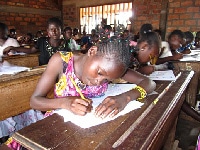 |
| © UNICEF CAR/2011 |
| Children in the Central African Republic writing letters of encouragement to children in Japan. |
On 4 October, letters from children in the Central African Republic were delivered to the children of Kashima Primary School in Minamisoma City, Fukushima Prefecture. Etsuko Matsunaga, who had worked as a Monitoring Evaluation Officer at the UNICEF office in the Central African Republic until last month, is currently in Japan for a short period before her dispatch to the UNICEF Afghanistan Office later this month. On this occasion Ms. Matsunaga delivered the letters to the students together with the Japan Committee for UNICEF (JCU). Ms. Matsunaga had collected the inspiring letters written by children in the Central African Republic following the 11 March disaster, and sent them to JCU so that they could be delivered to children in the affected areas.
After the disaster, the 22 primary and junior high schools of Minamisoma City were integrated into four. Kashima Primary School is one of the four schools that received students from the other affected schools. The Kashima Primary School building hosts a different primary school on each of its floors. A school that used to be home to around 200 students is now home to nearly 1,000, and all of these children attend class in the same building. Moreover, as temporary classrooms have been constructed in the schoolyard, the children are unable to take physical education classes outside.
As one could imagine, the school is home to a wide range of students, but once JCU stepped into the classroom, all of the students greeted the staff with big smiles on their faces.
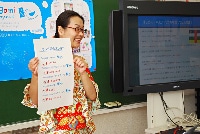 |
| © Japan Committee for UNICEF |
| UNICEF staff Ms. Etsuko Matsunaga. |
When Ms. Matsunaga first asked, “Does anybody know where the Central African Republic is located?” everybody immediately raised their hand! One boy stood in front of the class and correctly located the country on the map. He was presented with a children’s book written in French, one of the official languages of the Central African Republic.
The children learned dozens of interesting fun facts about the country’s industry, culture, languages, and even foods such as cassava, which the children discovered was a basic ingredient in tapioca. The traditional African dress that Ms. Matsunaga wore during her visit was made from locally grown cotton, one of the Central African Republic’s main industries. The Central African Republic is an abundant resource for ebony wood, a strong and beautiful wood used to make furniture and figurines. However, despite being a country of such rich natural resources, six in ten people live on less than US$1.25 per day, and four out of every ten children age five or younger suffers from stunted growth, an indicator of chronic malnutrition. There are also children that die because of measles and unsanitary water. Upon learning about the situation in the Central African Republic, the children appeared to reflect on their own situations, where access to vaccines and clean water protects them from serious illness, and where 100 yen is not nearly enough to live on everyday. Furthermore, upon hearing that one of the reasons that girls cannot go to school is because of early marriage, many children were unable to control their surprise, particularly after hearing that some girls get married at the age of 11 and have babies at the age of 13, the same age as children in the classroom.
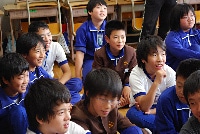 |
| © Japan Committee for UNICEF |
The children seemed very proud when Ms. Matsunaga told them about what other children in the world think about Japan: “People around the world love Japan and have been supporting us since the disaster. Japan is facing a difficult time with the disaster now, but Japan also wants to save people around the world. We have to build primary schools in places where children have no schools and we have to help other countries when they are in need, as they would for us. The Government of Japan builds primary schools in the Central African Republic, and the buildings that Japan builds are awesome! Children in the Central African Republic always say, ‘I want to go to that school!’ They really appreciate the assistance that Japan provides.”
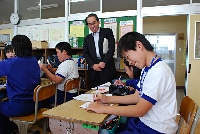 |
| © Japan Committee for UNICEF |
After learning a lot about the Central African Republic from Ms. Matsunaga’s presentation, which incorporated pictures of animals and other materials, the students were given the letters from the children in Africa. All of the letters from the Central African Republic were decorated with colorful drawings of flowers. Seeing the drawings of flowers that they had never seen before, the children immediately began to talk about how cute they were, asking the teachers what type of flowers the children had drawn.
The children then wrote replies with pictures and folded origami, expressing thanks in their own way.
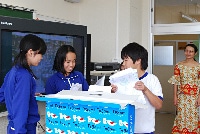 |
| © Japan Committee for UNICEF |
In closing, Ms. Matsunaga delivered the following message to the children of Kashima Primary Schools: “It has been a true pleasure meeting you all today. I’m sure that you all have your own dreams for the future, and I have a feeling that we will see each other again someday. The world is growing smaller and smaller. We have just met today, and that means our relationship starts now, so I ask you all to always be my friend. Who knows? One day we may be able to actually work together. Thank you very much.”
As Ms. Matsunaga left the school, the school principal thanked her using a new phrase that he had just learned in Sango, one of the country’s official languages. “Singila mingi” (thank you very much), he said.